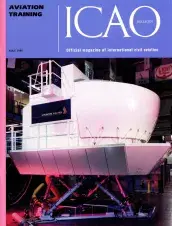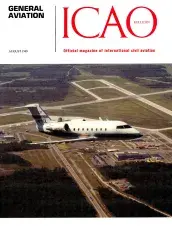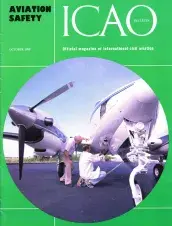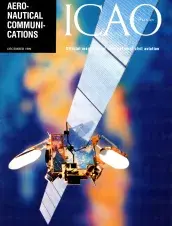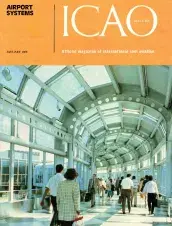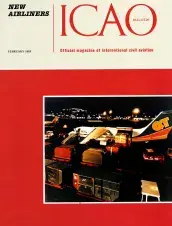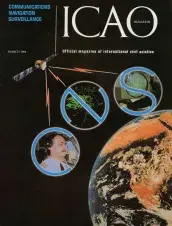Journal OACI
The objective of the Journal is to provide a concise account of the activities of the International Civil Aviation Organization and to feature additional information of interest to Contracting States and the international aeronautical world.
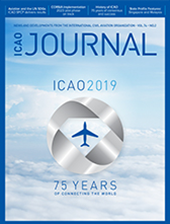 (ICAO Journal is available in English only from 2013)
(ICAO Journal is available in English only from 2013)
Singapore Airlines will be one of the first to implement the highly advanced B-747-400 electronic flight management system. Special arrangements were made with Boeing and Singapore Airlines to accommodate initial aircrew training at the Montreal headquarters of CAE Electronics, developer of this simulator. Training was begun just after in-plant acceptance of the training system last August.
The camera, over Quebec City Airport in Canada, has captured an unusual mix of aircraft which includes a Canadair Challenger 601-3A in flight and on the ground (centre) an Air France Concorde and (centre, right) the Province of Quebec's Service Aerien CL-215 water bombers used for fighting forest fires.
This massive en-route radar antenna, shown being assembled by Westinghouse technicians, is part of a fully unattended, all solid-state, long range radar system now in development. Up to 52 of these ARSR-4s will be deployed throughout the United States as part of the FAA's Radar Replacement Programme.
This Bendix/King Kingaire has been used as a flying laboratory by the firm to flight test its developmental TCAS-II, a traffic alert and collision avoidance system. As part of the test and evaluation effort, the instrumented aircraft is used as an "intruder," flying against the company's similarly equipped Sabreliner.
The "midnight oil" burned frequently at ICAO's Headquarters building during the recent three-week triennial 27th Session of the Assembly. Delegates from most of the Organization's 161 Member States came to Montreal to discuss problems and determine solutions, establish future policies, approve a programme budget and let the world know their concensus on a number of issues critical to the growth, safety and security of international civil aviation.
The first model of Eutelsat 11, shown here in an artist's conception, is in final systems integration at Aerospatiale's Cannes centre. The Eutelsat organization, which provides telephone, television and data transmission services to 26 European countries has already ordered 5 of these satellites for launches starting in 1990. Aeronautical communications relay will be among the various services provided, and could include passenger air-ground telecommunications. Increased traffic to be sent over the system led to Eutelsat's decision to order the new, higher performance generation of satellites. Eutelsat 11 has twice the capacity of its predecessor ECS and is expected to provide better coverage of its service area which stretches from Iceland to Turkey. Eutelsat 11 offers significant operational flexibility (beams can be re-configured in flight, for example) and high transmission power (50 watts). Eutelsat II is a Spacebus 100-type spacecraft with 3-axis stabilization and a power supply of 3 kW. Its mass in geostationary orbit is 985 kg. Eutelsat II satellites are built by a team led by Aerospatiale: Aeritalia (Italy), Alcatel-Espace (France), CASA (Spain), Ericsson Radio Systèmes (Sweden), ETCA (Belgium), Marconi Space Systems (Great Britain), MBB (Germany) and Crouzet (France).
United Airlines' new terminal at Chicago's O'Hare International Airport embodies a different form of architectural design, with considerable emphasis on use of natural light. It employs two long parallel concourses, called Terminal One, that are connected by an underground passageway. Shown is one of two hallways connecting Terminal One to the previous terminal complex.
Smaller, more efficient aircraft are finding a particular market with the regional and commuter carriers. Some operators have even "sized down" from the larger twin and trijets used previously. Typical of the newer breed of airliner for such operations is the four-engine British Aerospace 146. Shown here is the newest of the family -- the BAe 146-QT, called the "Quiet Trader." Designed as a small package air freighter, it is powered by Avco Lycoming ALF502 high bypass turbofans.
Increasingly, the demand grows louder within the civil aviation community for better, more integrated telecommunications, global navigation and air traffic surveillance. More recently, this need has led to new efforts in one region for development of a consolidated European concept that would merge the best features of existing satellite-based systems. The result is a proposed, harmonized GRANAS/Navsat system to provide CNS.


